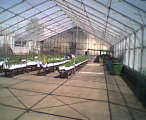|
Shoot
Cadmium Accumulation of Maize, Sunflower, Flax, and Spinach as
Related to Root Physiology and Rhizosphere Effects
Cadmium Anreicherung im Spross unterschiedlicher Pflanzenarten in
Beziehung zu physiologischen Wurzeleigenschaften und
Rhizosphäreneffekten
(Dr. agr. Christos Stritsis, Dr. Bernd Steingrobe, Prof. Dr.
Norbert Claassen)
URL der Dissertation:
http://webdoc.sub.gwdg.de/diss/2011/stritsis/stritsis.pdf
Abstract (ENG)
Plants differ widely in Cd accumulation when grown on Cd
contaminated soils. This is because several soil properties interact
with several plant properties. Plant factors determining the shoot
Cd concentration of plants are the root-shoot ratio [surface area
(RA) per unit of shoot dry weight (SDW)], the relative shoot growth
rate (RGRS), the Cd total net influx (Int) and the proportion of
absorbed Cd that is translocated from the root to the shoot (p). And
the Cd influx is furthermore influenced by plant properties like the
Cd uptake kinetics and the ability of the root to affect the Cd
solubility in the rhizosphere. The aim of this research was to
assess the significance of the above mentioned plant properties for
the shoot Cd accumulation for different plant species. A growth
chamber experiment was carried out with maize, sunflower, flax, and
spinach growing on a sandy soil to which 0, 14 and 40 μmol Cd kg-1
were added resulting in a Cd soil solution concentration of 0.04,
0.68 and 2.51 μmol L-1. At the high Cd addition (40 μmol kg-1) SDW
of flax and spinach was significantly decreased by 20% and 40%,
respectively while maize and sunflower showed no yield depression.
The shoot Cd concentration of plants increased in all species
linearly with the Cd addition to the soil. The Cd concentration in
shoots varied between maize and spinach by a factor of about 30,
sunflower and flax were in between. The root-shoot ratio (RA/SDW)
varied by a factor of two and the RGRS by a factor of 1.5. The main
factor related to different Cd concentrations in shoots was the Cd
shoot influx which varied between maize and spinach by a factor of
almost 40 at low and by a factor of 26 at high Cd addition.
Differences in Cd influx among species may be based on their ability
to solubilize Cd in soil or on differences in Cd uptake kinetics.
Plants had a strong effect on Cd concentration in soil solution,
CLi, i.e. plant growth decreased (maize, sunflower) as well as
increased (flax, spinach) CLi. The decrease of CLi at low Cd
addition was not related to Cd uptake by the plants, since maize
with the lowest Cd uptake showed the strongest decrease of CLi
(about 65%), whereas spinach with the highest Cd uptake, showed the
least decrease of CLi (about 20%) indicating a Cd immobilization in
soil caused from root activity of maize or spinach. In contrast to
decreasing, CLi was increased by flax at both Cd levels up to 100%
and by spinach by 23% at the high Cd addition to the soil. Plants
therefore solubilized more Cd as was taken up by them. However,
these effects did not totally explain the observed differences in
their Cd influx. Further explanations were sought by using
mechanistic modeling to simulate Cd uptake from soil. Modeling
allowed including not only the effect plants had on CLi but also
their different Cd uptake kinetics. Uptake kinetics was described by
the root absorbing power, α, which is the slope of the uptake
isotherm, which is almost constant in the low concentration range as
found in the soils of this experiment. The simulated Cd influx was
always higher than the measured one and for maize and flax it was
about 10 times higher. The sensitivity analysis showed that the Cd
soil solution concentration, CLi, should be reduced by 90% for maize
and by 37% for spinach in order for the simulated Cd influx to
become the same as the measured one. The changes of the α value lead
to similar results. The sequential Cd fractionation in the soil with
and without plants demonstrated that plants affect the Cd binding in
soil. For spinach and sunflower 70% of Cd was found in the mobile
and easily mobilizable fraction while for flax it was only 55%. In
Mn oxides occluded Cd decreased in spinach and sunflower between
5-10% and in organically bound Cd increased in maize and flax about
5%. The other fractions contained only 5% of the total cadmium that
was bound to solid phase. However, the effect different plants had
on Cd binding in soil was not related to the effect they had had on
Cd concentration in the soil solution.
Abstract (GER)
Pflanzen unterscheiden sich in der Cd-Aufnahme und -Akkumulation,
wenn sie auf mit Cd kontaminierten Böden wachsen. Dies ist darin
begründet, dass mehrere Pflanzeneigenschaften mit mehreren
Bodeneigenschaften interagieren. Der Cd-Gehalt im Spross (XS) hängt
ab von: a) der Größe des Wurzelsystems, charakterisiert durch das
Wurzel-Spross-Verhältnis, WSV (RA/WS, Wurzeloberfläche zu
Sprossgewicht, b) der relativen Wachstumsrate des Sprosses (RGRS),
c) dem Netto-Influx (Int,) und d) dem Anteil des aufgenommenen Cd,
der in den Spross verlagert wird (p). Der Cd Influx hängt u.a. ab
von der Cd Aufnahmekinetik und der Mobilisierung des Cd im Boden
durch die Wurzel. Ziel dieser Arbeit war es, die Bedeutung der oben
genannten Pflanzeneigenschaften für die Cd Akkumulation im Spross
verschiedener Pflanzenarten zu untersuchen. Hierfür wurde Mais,
Sonnenblume, Öllein, und Spinat auf einem sandigen Boden (pHCaCl2
4,5, 2,8% C, 5% Ton) mit drei Cd Stufen (0, 14 und 40 µmol kg-1
Boden, was in einer Cd Konzentration in der Bodenlösung von 0,04,
0,68 und 2,51 µmol L-1 resultierte) angezogen. Bei der hohen Cd
Zufuhr (40 µmol kg-1), wurde die Trockenmasse, TM, von Öllein und
Spinat signifikant um 20% bzw. 40% reduziert während Mais und
Sonnenblume keine TM-Depression zeigten. Der Cd Gehalt im Spross
erhöhte sich in allen Pflanzenarten linear mit steigender Cd Zufuhr
zum Boden. Er variierte zwischen Mais und Spinat um den Faktor 30,
Die Cd-Gehalte von Sonnenblume und Öllein lagen dazwischen. Das WSV
variierte um den Faktor 2 bis 3, wobei Spinat den niedrigsten Wert
hatte und die RGRS variierte um maximal 1,7. Die Variation in dem
WSV und der RGRS konnten die Unterschiede im Cd-Gehalt der
Pflanzenarten nicht erklären. Es war vor allem der Cd Sprossinflux,
der zwischen Mais und Spinat bis um den Faktor 40 variierte, der die
unterschiedlichen Cd-Gehalte im Spross bestimmte. Der
unterschiedliche Cd-Influx könnte darin begründet sein, dass
Pflanzen Cd im Boden unterschiedlich stark lösen bzw. mobilisieren
oder eine unterschiedliche Cd-Aufnahmekinetik besitzen. Pflanzen
hatten einen starken Einfluss auf die Cd-Konzentration in der
Bodenlösung, CLi. Mais und Sonnenblumen erniedrigten Spinat und
Öllein erhöhten sie. Die Abnahme von CLi bei niedriger Cd Zufuhr war
nicht in der Cd Aufnahme durch die Pflanzen begründet, da Mais mit
der niedrigsten Cd-Aufnahme die stärkste (ca. 65%), dagegen Spinat
mit der höchsten Cd-Aufnahme die geringste Abnahme von CLi (ca. 20%)
zeigte. Dies deutet auf eine Cd Immobilisierung im Boden durch Mais
bzw. Spinat hin. Im Gegensatz zur Abnahme, wurde CLi durch Öllein
bei beiden Cd Zugaben um bis zu 100% und von Spinat um 23% bei der
hohen Cd Zufuh r zum Boden erhöht. Pflanzen mobilisierten daher mehr
Cd als sie aufnahmen. Diese Effekte konnten die beobachteten
Unterschiede im Cd Influx jedoch nicht vollständig erklären. Mit
Hilfe einer mechanistischen Modellierung der Cd-Aufnahme aus dem
Boden wurde neben der Wirkung der Pflanzen auf CLi auch deren
Aufnahmekinetik berücksichtigt. Die Aufnahmekinetik wurde mit der
Wurzel-Aufnahmefähigkeit (root absorbing power), α, beschrieben,
welche das Steigungsmaß der Aufnahme Isotherme ist, die, im
niedrigen Konzentrationsbereich, nahezu konstant ist. Der mit dem
Modell berechnete Cd Sprossinflux war stets höher als der gemessene,
bei Mais und Öllein sogar um den Faktor 10. Die Sensitivitätsanalyse
zeigte, dass CLi, um 90% bei Mais und um 37% bei Spinat verringert
werden müsste, um eine Übereinstimmung des gemessenen mit dem
berechneten Cd Sprossinflux zu erreichen. Die Veränderung von
α-Werten führte zu ähnlichen Ergebnissen. Die sequentielle
Fraktionierung von Cd im Boden mit und ohne Pflanzen zeigte, dass
die Pflanzen die Cd-Bindung im Boden beeinflussten. Bei Spinat und
Sonnenblume wurden 70% des Cd in der mobilen und leicht
mobilisierbaren Fraktion gefunden, während es bei Öllein nur 55%
waren. Die in Mn Oxiden okkludierte Fraktion verringerte sich bei
Spinat und Sonnenblume zwischen 5-10% und die organisch gebundene
Fraktion stiegt bei Mais und Öllein um etwa 5% an. Die restlichen
Fraktionen enthielten nur 5% des gesamten Cd des Bodens. Die Wirkung
der Pflanzen auf die Cd Bindung im Boden stand jedoch in keiner
Beziehung zu deren Wirkung auf die Cd-Konzentration in der
Bodenlösung.
Weitere
Publikationen:
|











